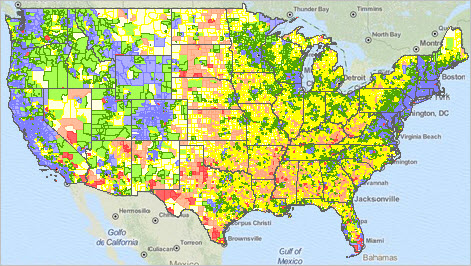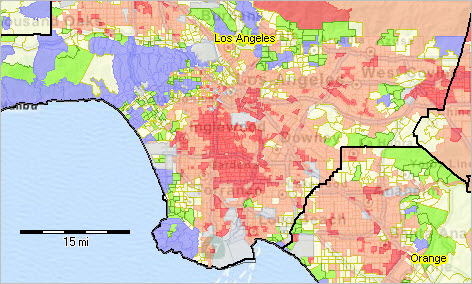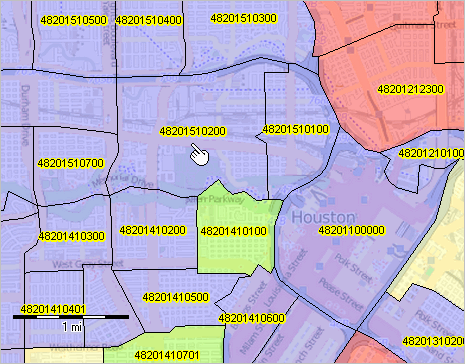

|
|
Census Tract ACS 2015 Housing Characteristics -- tools & data to analyze neighborhood level housing, tenure, occupancy, value, rent, more
Census tracts are important for many reasons. It is easy to misidentify or misunderstand patterns and characteristics within cities, counties and metros which can become blurred using these higher level, more aggregate geographies alone. Many cities and counties that might be experiencing demographic-economic decline will often have bright spots that are groups of a few or many census tracts. This section is focused on tools, resources and methods that you can use to access, integrate and analyze U.S. by census tract housing characteristics data. The U.S. national scope Census Tracts Demographic-Economic Dataset contains approximately 600 subject matter items tabulated for each census tract organized into four subject matter groups: • General Demographics • Social Characteristics • Economic Characteristics • Housing Characteristics (this section) Use the interactive table in this section to view, query, rank, compare general demographics for all tracts in the U.S. Data in this section are based on the American Community Survey (ACS) 2015 5-year estimates. Access to the interactive table below requires your ProximityOne User Group ID. Join now. There is no fee. Current Estimates & Projections ACS tract/small area estimates lag by four years or more between the current year and reference year. There are not annual estimates but estimates based on a 5-year survey. Use the ProximityOne annual tract estimates and projections 2010 through 2022 for current estimates and anticipated change 5 years ahead. Patterns of Median Housing Value by Census Tract The following graphic shows median housing value (item H088 in interactive table below) by census tract based on ACS 5 year estimates. Click graphic for larger view, more detail and legend color/data intervals. This map illustrates the geographic level of detail available using census tract demographics and the relative ease to gain insights using geospatial data analytics tools.  - View developed using CV XE GIS and related GIS project. Patterns of Median Housing Value by Census Tract -- Los Angeles Metro The following graphic shows the same subject matter as above for a portion of the Los Angeles metro. Accommodating different demographic-economic thresholds/patterns, different legend color/data intervals are used. The pattern layer is set to 80% transparency enabling a view of earth features. Click graphic for larger view, more detail and legend color/data intervals.  - View developed using CV XE GIS and related GIS project. Get a Custom Map for Your Area of Interest Use this form to request a no fee map graphic similar to the one shown above for a county of interest. Enter the request with county name and state in the text section; e.g., "Requesting housing tract map for Cook County, IL." Use the interactive ranking table in this section to view, query, rank, compare housing characteristics of the population, households and families in these areas. The scroll box shown below lists each of the subject matter items available for each area via the ranking table. The number at the left of the subject matter item is also used as the short name for the subject matter item in the column header in the ranking table. Housing Characteristics Items .. a few item names and numbers changed from previous year data/table.
HOUSING OCCUPANCY
H001 Total housing units H002 Occupied housing units H003 Vacant housing units H004 Homeowner vacancy rate H005 Rental vacancy rate UNITS IN STRUCTURE H006 Total housing units H007 1-unit, detached H008 1-unit, attached H009 2 units H010 3 or 4 units H011 5 to 9 units H012 10 to 19 units H013 20 or more units H014 Mobile home H015 Boat, RV, van, etc. YEAR STRUCTURE BUILT H016 Total housing units H017 Built 2014 or later H018 Built 2010 or 2013 H019 Built 2000 to 2009 H020 Built 1990 to 1999 H021 Built 1980 to 1989 H022 Built 1970 to 1979 H023 Built 1960 to 1969 H024 Built 1950 to 1959 H025 Built 1940 to 1949 H026 Built 1939 or earlier ROOMS H027 Total housing units H028 1 room H029 2 rooms H030 3 rooms H031 4 rooms H032 5 rooms H033 6 rooms H034 7 rooms H035 8 rooms H036 9 rooms or more H037 Median rooms BEDROOMS H038 Total housing units H039 No bedroom H040 1 bedroom H041 2 bedrooms H042 3 bedrooms H043 4 bedrooms H044 5 or more bedrooms HOUSING TENURE H045 Occupied housing units H046 Owner-occupied H047 Renter-occupied H048 Average household size of owner-occupied unit H049 Average household size of renter-occupied unit YEAR HOUSEHOLDER MOVED INTO UNIT H050 Occupied housing units H051 Moved in 2015 or later H052 Moved in 2010 to 2014 H053 Moved in 2000 to 2009 H054 Moved in 1990 to 1999 H055 Moved in 1980 to 1989 H056 Moved in 1979 or earlier VEHICLES AVAILABLE H057 Occupied housing units H058 No vehicles available H059 1 vehicle available H060 2 vehicles available H061 3 or more vehicles available HOUSE HEATING FUEL H062 Occupied housing units H063 Utility gas H064 Bottled, tank, or LP gas H065 Electricity H066 Fuel oil, kerosene, etc. H067 Coal or coke H068 Wood H069 Solar energy H070 Other fuel H071 No fuel used SELECTED CHARACTERISTICS H072 Occupied housing units H073 Lacking complete plumbing facilities H074 Lacking complete kitchen facilities H075 No telephone service available OCCUPANTS PER ROOM H076 Occupied housing units H077 1.00 or less H078 1.01 to 1.50 H079 1.51 or more VALUE H080 Owner-occupied units H081 Less than $50,000 H082 $50,000 to $99,999 H083 $100,000 to $149,999 H084 $150,000 to $199,999 H085 $200,000 to $299,999 H086 $300,000 to $499,999 H087 $500,000 to $999,999 H088 $1,000,000 or more H089 Median (dollars) MORTGAGE STATUS H090 Owner-occupied units H091 Housing units with a mortgage H092 Housing units without a mortgage SELECTED MONTHLY OWNER COSTS (SMOC) H093 Housing units with a mortgage H094 Less than $500 H095 $500 to $999 H096 $1,000 to $1,499 H097 $1,500 to $1,999 H098 $2,000 to $2,499 H099 $2,500 to $2,999 H100 $3,000 or more H101 Median (dollars) H102 Housing units without a mortgage H103 Less than $250 H104 $250 to $399 H105 $400 to $599 H106 $600 to $799 H107 $800 to $999 H108 $1,000 or more H109 Median (dollars) SELECTED MONTHLY OWNER COSTS AS A PERCENTAGE OF HOUSEHOLD INCOME (SMOCAPI) H110 Housing units with a mortgage (excluding units where SMOCAPI cannot be computed) H111 Less than 20.0 percent H112 20.0 to 24.9 percent H113 25.0 to 29.9 percent H114 30.0 to 34.9 percent H115 35.0 percent or more H116 Not computed H117 Housing unit without a mortgage (excluding units where SMOCAPI cannot be computed) H118 Less than 10.0 percent H119 10.0 to 14.9 percent H120 15.0 to 19.9 percent H121 20.0 to 24.9 percent H122 25.0 to 29.9 percent H123 30.0 to 34.9 percent H124 35.0 percent or more H125 Not computed GROSS RENT H126 Occupied units paying rent H127 Less than $500 H128 $500 to $999 H129 $1,000 to $1,499 H130 $1,500 to $1,999 H131 $2,000 to $2,499 H132 $2,500 to $2,999 H133 $3,000 or more H134 Median (dollars) H135 No rent paid GROSS RENT AS A PERCENTAGE OF HOUSEHOLD INCOME (GRAPI) H136 Occupied units paying rent (excluding units where GRAPI cannot be computed) H137 Less than 15.0 percent H138 15.0 to 19.9 percent H139 20.0 to 24.9 percent H140 25.0 to 29.9 percent H141 30.0 to 34.9 percent H142 35.0 percent or more H143 Not computed Example To determine the census tracts with the highest median value (occupied housing units) in Texas: - Click ShowAll button. Click State dropdown and select Texas. - Use horizontal scroll bar to make column H088 visible. - Click once on H088 column header then click once more on H088 column header (to sort descending). - 332 tracts are top-coded at $1,000,000; the tract with the highest median household income cannot be determined. Census Tract ACS 2015 Housing Characteristics Interactive Table Access to the table data requires a User Group ID. Join now. There is no fee. Click column header to sort; click again to sort other direction. See usage notes below table. Data based on ACS 2015 5 year estimates. See related interactive tables 73,056 tracts; initial load may require 10 seconds; Click row to copy to clipboard Usage Notes • Tract code column: Census 2010 census tract code structured as 11 characters: - ss (state postal code) + ccc (county FIPS code) + tttttt (Census 2010 census tract code). - all 11 characters required to uniquely identify a tract code. • Use Select Tract button to select one tract: - enter 11-character State+County FIPS code in edit box at right of Tract button. - click ShowAll button. - click Select Tract button to view/analyze selected tract. • Use StCty button to select/filter for all tracts in a county: - enter 5-character State+County FIPS code in edit box at right of StCty button. - click ShowAll button. - click StCty button to view/analyze tracts in this county. • Use CBSA button to select/filter for all tracts in a CBSA/metro: - get 5-character CBSA code from scroll section at right above table. - enter CBSA 5-character code in edit box at right of CBSA button. - click ShowAll button. - click CBSA button to view/analyze tracts in this CBSA. • Click ShowAll button between specific queries. • Cells with -1 value could not be estimated (for this geography and this time frame). Use address look-up tool to determine census tract, city/place and other geocode/area name/demographics based on address. View of Houston Area Showing Tract 48201510200 Create a similar view using the default US1.GIS project distributed with the CVXEGIS software. 
Importance of Census Tracts for Data Analytics Census tracts are important for many reasons. • Covering the U.S. wall-to-wall, census tracts are the preferred "small area" geography for superior data analytics. • The Census Bureau now produces annual tract demographic-economic data from the American Community Survey; .. there is an evolving time-series at the tract level creating new analytical opportunities. • Originally developed to equivalence neighborhoods, many still do. • Defined by the Census Bureau in collaboration with local groups, .. tracts typically reflect boundaries meaningful for local area analysis. • Defined generally for use with each new decennial census, most tract boundaries are stable .. and non-changing for ten years and many much longer. • Designed to average 4,000 population, .. there are more than twice as many census tracts (73,056) than ZIP code areas (33,129). • Tract boundaries are well-defined; unlike ZIP code areas which are subject to multi-sourced geographic definitions. • Many data developers (e.g., epidemiologists) use census tract geography to tabulate their own small area data .. enabling more effective use of those data with Census Bureau census tract data. • A statistical geographic area (in contrast to politically defined areas), .. census tracts are coterminous with counties; .. data at the census tract level can be aggregated to the county level. • Small area estimates for tracts are typically more reliable than for block groups. .. census tracts are comprised on one or more coterminous block groups. .. on average, a census tract is comprised of three block groups. • Census tracts are used by many Federal, state and local governments for compliance and program management. The ACS provides "richer" demographic-economic characteristics for national scope census tracts. While Census 2010 provides data similar to those items in the General Demographics section, only ACS sourced data provide details on topics such as income and poverty, labor force and employment, housing value and costs, educational participation and attainment, language spoken at home, among many related items. The approximate 600 items accessible via the tract dataset are supplemented by a wide range of additional subject matter. ACS census tract data are updated annually in December of each year. Find Geocodes Based on Address go top Summary of steps to use the "Find tract code based on address..." tool located in the upper right of this page. • Enter an address in the three line form (no ZIP code). • Click Find button and the census tract and related geocodes are returned. • Copy the last 11 digits of the returned GEOID to clipboard (e.g., 06085508101). • Paste that value in the edit box to the right of the "Select Area" button below the interactive table. • Replace the first two characters (e.g., 06) with the uppercase USPS state abbreviation (e.g. CA). • Click the Select Area button; the table refreshes with the selected tract. .. optionally right click the row and copy tract attributes to clipboard. .. paste in application such as spreadsheet program. .. join us in a Data Analytics Lab session to review use of operations. • Table empty? Click the ShowAll button then click Select Area button again. Use the Location-Based Demographics tool to view a demographic profile for an address. ProximityOne User Group Join the ProximityOne User Group to keep up-to-date with new developments relating to metros and component geography decision-making information resources. Receive updates and access to tools and resources available only to members. Use this form to join the User Group. Support Using these Resources Learn more about accessing and using demographic-economic data and related analytical tools. Join us in a Data Analytics Lab session. There is no fee for these one-hour Web sessions. Each informal session is focused on a specific topic. The open structure also provides for Q&A and discussion of application issues of interest to participants. Additional Information ProximityOne develops geodemographic-economic data and analytical tools and helps organizations knit together and use diverse data in a decision-making and analytical framework. We develop custom demographic/economic estimates and projections, develop geographic and geocoded address files, and assist with impact and geospatial analyses. Wide-ranging organizations use our tools (software, data, methodologies) to analyze their own data integrated with other data. Follow ProximityOne on Twitter at www.twitter.com/proximityone. Contact us (888-364-7656) with questions about data covered in this section or to discuss custom estimates, projections or analyses for your areas of interest. |
|
|